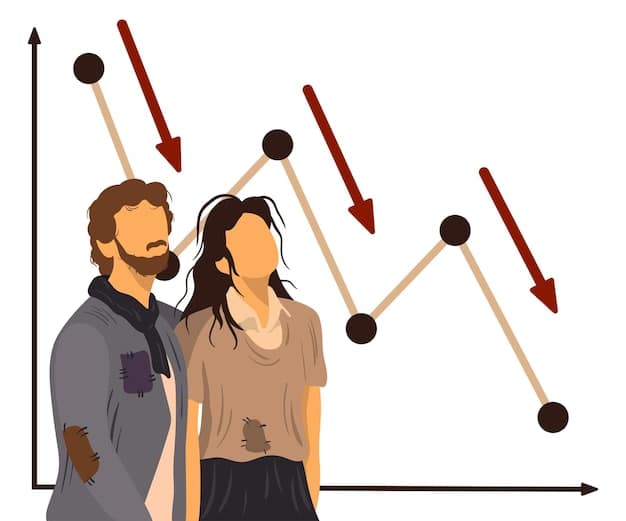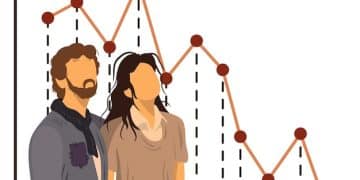Inflation Rate Soars to 5.2%: Expert Insights & Investment Guide

Inflation Rate Surges to 5.2%: Expert Analysis and Investment Strategies examines the causes, impacts, and potential investment strategies to navigate the current inflationary environment in the United States, providing insights for consumers and investors.
The latest economic data reveals a concerning trend: the inflation rate surges to 5.2%, exceeding expectations and sending ripples through financial markets. This article breaks down the factors driving this surge and offers expert analysis on how to protect your investments during these uncertain times.
Understanding the Inflation Surge: Key Factors
The recent jump in the inflation rate to 5.2% has caught many economists and investors off guard. Understanding the underlying causes is crucial for anticipating future trends and making informed financial decisions. Several factors are contributing to this inflationary pressure, creating a complex economic landscape.
Supply Chain Disruptions
Ongoing supply chain bottlenecks continue to exert upward pressure on prices. From raw materials to finished goods, delays and shortages are driving up production costs, which are then passed on to consumers.
Increased Consumer Demand
Fueled by pent-up demand and government stimulus, consumer spending remains robust. While a strong economy is generally positive, excessive demand can outstrip supply, leading to higher prices.
Labor Market Tightness
The labor market is experiencing significant tightness, with businesses struggling to fill open positions. This has led to wage increases, which, while beneficial for workers, can also contribute to inflationary pressures.

- Global Events: Geopolitical tensions and global events can disrupt supply chains and energy markets, further exacerbating inflationary pressures.
- Energy Prices: Fluctuations in energy prices, particularly oil and gas, have a direct impact on transportation costs and consumer prices.
- Government Policies: Fiscal and monetary policies implemented by the government play a crucial role in shaping inflationary trends.
In conclusion, the 5.2% inflation surge is a multifaceted issue stemming from a combination of supply-side constraints, robust consumer demand, and a tight labor market. Addressing these underlying factors is essential for taming inflation and maintaining economic stability.
Impact on Consumers and Businesses
The surge in the inflation rate to 5.2% has far-reaching consequences for both consumers and businesses. The increased cost of goods and services erodes purchasing power, impacting household budgets and business profitability. Understanding these impacts is essential for making informed financial decisions and implementing strategies to mitigate the negative effects.
Consumers are feeling the pinch as everyday expenses such as groceries, gasoline, and housing become more expensive. This can lead to difficult choices, as households are forced to cut back on discretionary spending and prioritize essential needs. Businesses, too, are facing challenges as rising input costs squeeze profit margins and force them to raise prices.
Decreased Purchasing Power
Inflation erodes the value of money, meaning that each dollar buys less than it did before. This decreased purchasing power can have a significant impact on household budgets, particularly for low- and middle-income families.
Reduced Business Profitability
Rising input costs, such as raw materials, labor, and transportation, can squeeze business profit margins. Companies may be forced to raise prices to maintain profitability, which can lead to decreased sales and customer attrition.
- Increased Borrowing Costs: As the Federal Reserve raises interest rates to combat inflation, borrowing costs for consumers and businesses increase. This can impact major purchases such as homes and cars, as well as business investments.
- Uncertainty and Volatility: High inflation can create uncertainty and volatility in financial markets, making it difficult for businesses to plan for the future and for investors to make informed decisions.
- Changes in Consumer Behavior: Consumers may change their spending habits in response to inflation, opting for cheaper alternatives or cutting back on non-essential purchases.
In summary, the 5.2% inflation surge presents significant challenges for consumers and businesses alike. Addressing the underlying causes of inflation and implementing strategies to mitigate its impact are crucial for maintaining economic stability and protecting financial well-being.
Expert Analysis: What Economists Are Saying
The unexpected jump in the inflation rate to 5.2% has prompted a flurry of analysis from economists and financial experts. Their insights provide valuable perspectives on the causes, implications, and potential policy responses to this inflationary pressure. Understanding these expert opinions can help investors and consumers make more informed decisions.
Economists are closely monitoring various economic indicators to assess the trajectory of inflation. Some argue that the current surge is a temporary phenomenon driven by transient factors, while others believe that it signals a more persistent inflationary trend.
Transitory vs. Persistent Inflation
One of the key debates among economists is whether the current inflation is transitory or persistent. Transitory inflation is expected to fade as supply chain bottlenecks ease and demand normalizes, while persistent inflation could require more aggressive policy responses.
The Role of the Federal Reserve
The Federal Reserve plays a crucial role in managing inflation through monetary policy. Economists are closely watching the Fed’s actions, such as interest rate hikes and quantitative tightening, to assess their impact on inflation and economic growth.

- Impact of Fiscal Policy: Government spending and tax policies can also influence inflation. Economists are analyzing the potential impact of fiscal stimulus measures on inflationary pressures.
- Global Economic Outlook: The global economic outlook plays a significant role in shaping inflationary trends. Economists are monitoring international developments to assess their impact on the US economy.
- Expectations and Sentiment: Inflation expectations and consumer sentiment can also influence price behavior. Economists are tracking these indicators to gauge the potential for a self-fulfilling inflationary spiral.
In conclusion, expert analysis provides valuable insights into the complexities of the current inflationary environment. Staying informed about these perspectives can help investors and consumers navigate the challenges and opportunities presented by rising prices.
Investment Strategies for an Inflationary Environment
In an environment where the inflation rate surges to 5.2%, it’s crucial to adjust your investment strategy to protect your portfolio from erosion. Certain asset classes tend to perform better during inflationary periods, offering potential opportunities for growth and capital preservation. Diversification and a long-term perspective are key to navigating these challenging market conditions.
Inflation erodes the value of fixed-income investments, such as bonds, as rising prices diminish the purchasing power of future interest payments. Therefore, investors should consider strategies that can outperform inflation, such as investing in inflation-protected securities or asset classes with the potential for price appreciation.
Inflation-Protected Securities
Treasury Inflation-Protected Securities (TIPS) are designed to protect investors from inflation. The principal of TIPS is adjusted based on changes in the Consumer Price Index (CPI), providing a hedge against rising prices.
Real Estate
Real estate can serve as an inflation hedge, as property values and rental income tend to increase during inflationary periods. Investing in real estate investment trusts (REITs) can provide exposure to the real estate market without the need to directly own property.
- Commodities: Commodities such as gold, oil, and agricultural products tend to perform well during inflationary periods. Investing in commodity-linked ETFs or mutual funds can provide exposure to this asset class.
- Value Stocks: Value stocks, which are typically undervalued by the market, have historically outperformed growth stocks during inflationary periods.
- Diversification: Diversifying your portfolio across various asset classes can help mitigate the impact of inflation and reduce overall risk.
In summary, adapting your investment strategy to account for inflation is essential for protecting your portfolio and achieving your financial goals. Consider incorporating inflation-protected securities, real estate, commodities, and value stocks into your investment mix, while maintaining a diversified and long-term perspective.
Government and Federal Reserve Responses
When the inflation rate surges to 5.2%, it requires decisive action from both the government and the Federal Reserve. These entities employ various policy tools to address inflationary pressures and maintain economic stability. Understanding these responses is crucial for anticipating market movements and making informed investment decisions.
The government can use fiscal policy, such as tax increases or spending cuts, to influence aggregate demand and curb inflation. The Federal Reserve, on the other hand, primarily uses monetary policy tools, such as interest rate adjustments and quantitative tightening, to manage inflation and promote full employment.
Interest Rate Hikes
The Federal Reserve often raises interest rates to combat inflation. Higher interest rates make borrowing more expensive, which can help cool down the economy and reduce inflationary pressures.
Quantitative Tightening
Quantitative tightening involves the Federal Reserve reducing its holdings of government bonds and other securities. This reduces the money supply and can help curb inflation.
- Fiscal Policy Measures: The government may implement fiscal policy measures, such as tax increases or spending cuts, to reduce aggregate demand and curb inflation.
- Supply Chain Initiatives: Efforts to address supply chain bottlenecks can help alleviate inflationary pressures by increasing the availability of goods and services.
- Inflation Targeting: Many central banks, including the Federal Reserve, use inflation targeting as a framework for monetary policy. This involves setting a specific inflation target and adjusting policy to achieve that target.
Government and Federal Reserve responses are critical in managing inflation and maintaining economic stability. Monitoring these actions and their potential impact can help investors make more informed decisions and navigate the challenges of an inflationary environment.
Preparing Your Finances for Continued Inflation
With the inflation rate surges to 5.2%, it’s important to take proactive steps to prepare your finances for continued inflationary pressures. This involves budgeting, managing debt, and making strategic financial decisions to protect your purchasing power and maintain your financial well-being. Taking control of your finances now can help you weather the storm and emerge stronger in the long run.
Start by assessing your current financial situation and identifying areas where you can cut back on spending. Create a budget and track your expenses to ensure that you are living within your means. Prioritize essential needs over discretionary wants and look for ways to save money on everyday expenses.
Budgeting and Expense Tracking
Creating a budget and tracking your expenses can help you identify areas where you can cut back on spending and save money.
Debt Management
High inflation can make debt more difficult to manage. Consider consolidating your debts and exploring options for lowering your interest rates.
- Emergency Fund: Build an emergency fund to cover unexpected expenses and provide a financial buffer during challenging times.
- Investing in Yourself: Invest in your skills and education to increase your earning potential and improve your long-term financial prospects.
- Reviewing Insurance Coverage: Make sure you have adequate insurance coverage to protect yourself from unexpected financial losses.
Preparing your finances for continued inflation requires a proactive and strategic approach. By budgeting, managing debt, building an emergency fund, and investing in yourself, you can protect your financial well-being and navigate the challenges of a high-inflation environment.
| Key Point | Brief Description |
|---|---|
| 🔥 Inflation Drivers | Supply chain issues, strong demand, and labor shortages are key factors. |
| 💰 Consumer Impact | Reduced purchasing power affects household budgets. |
| 📈 Investment Tips | Consider TIPS, real estate, and commodities to hedge against inflation. |
| 🏦 Fed Response | Interest rate hikes and quantitative tightening are used to manage inflation. |
Frequently Asked Questions
▼
The inflation surge is primarily driven by supply chain disruptions, increased consumer demand, and a tight labor market. These factors have combined to create significant upward pressure on prices.
▼
Inflation erodes the value of money, meaning that each dollar buys less than it did before. This decreased purchasing power can significantly impact your ability to afford goods and services.
▼
Consider investing in inflation-protected securities (TIPS), real estate, commodities, and value stocks. Diversifying your portfolio is also crucial to mitigate the impact of inflation.
▼
The Federal Reserve is raising interest rates and implementing quantitative tightening measures to cool down the economy and reduce inflationary pressures. These actions aim to curb demand and stabilize prices.
▼
Create a budget, track your expenses, manage your debt, and build an emergency fund. Investing in yourself and reviewing your insurance coverage are also important steps to take.
Conclusion
The surge in the inflation rate to 5.2% presents significant challenges for consumers, businesses, and policymakers alike. By understanding the underlying causes, analyzing the expert opinions, and implementing proactive financial strategies, you can navigate the inflationary environment and protect your financial well-being. Stay informed, take control of your finances, and make informed decisions to secure your financial future.





